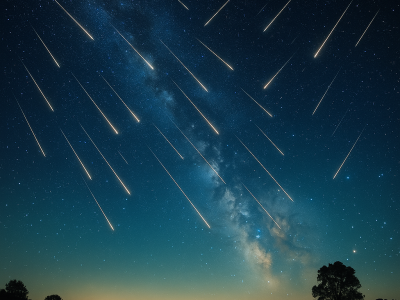It began like something out of a science fiction scene. In the early hours, the peaceful streets of McDonough, Georgia, were suddenly bathed in an otherworldly light. A streak of fire tore across the night sky, dazzling residents and rattling windows. Within seconds, the fireball vanished, but not before a fragment of it began a final descent into history, and into someone’s home.
By morning, the headlines would tell the world that a rock older than Earth itself had landed in a quiet suburban neighbourhood. But for the people who heard it, saw it, or touched it, the event was a direct connection to the cosmos.
The dramatic event
Witnesses later described the moment as both beautiful and terrifying. One neighbour, who was walking their dog, recalled the sharp hiss that followed the bright trail overhead. “It was like lightning, but travelling sideways,” they said. A deep rumble followed, then a sound like a heavy object crashing into wood.
Inside a modest home on a tree-lined street, the meteorite punched a hole through the roof, tore through insulation, dented an air duct, and finally came to rest on the floor. Homeowner Craig Bailey was at work when he received the news. “They told me something had come through the roof. I thought it was a joke,” he told reporters. But the charred, fusion-crusted rock lying among debris proved otherwise.
Local authorities quickly secured the site and contacted scientists at the University of Georgia. The rock was small, about the size of a large cherry tomato, but its arrival had been dramatic, captured in part by security cameras and dashcams across the region.
The scientific bombshell
Once in the lab, the meteorite began revealing its secrets. Researchers carefully removed dust and debris to avoid contamination, then cut tiny samples for isotopic analysis. Using uranium–lead dating, they measured the ratio of radioactive isotopes to their stable decay products. This “cosmic clock” showed an astonishing age: 4.56 billion years.
For comparison, Earth itself is about 4.54 billion years old. That means the McDonough meteorite formed some 20 million years before our planet took shape. It likely originated in the swirling disk of gas and dust, the solar nebula,that surrounded the young Sun.
“This is a time capsule from before our planet even existed,” said Dr Julia Cartwright, a meteoritics expert unaffiliated with the study. “We can use it to understand the raw materials that eventually built the Earth.”
The meteorite’s journey to Georgia began in the main asteroid belt between Mars and Jupiter. Scientists believe it may have been part of a larger asteroid broken apart by a collision roughly 470 million years ago, setting it on a slow, meandering path toward Earth.
What is a chondrite?
The McDonough meteorite belongs to a group known as low-metal ordinary chondrites. The name might sound technical, but these are among the most scientifically important meteorites. Chondrites are stony meteorites that contain tiny spherical grains called chondrules, i.e., molten droplets from the early solar system that cooled rapidly in space. They are, in a sense, cosmic breadcrumbs from the dawn of planetary history.
Low-metal chondrites, as the name suggests, have relatively little metallic iron and nickel. This makes them lighter and more stone-like than metallic meteorites, but it also means they have often escaped the intense heating that can erase early chemical signatures.
Scientists value chondrites because they are largely unaltered since their formation. Studying them is like examining the original recipe for planets. They preserve the solar system’s starting materials, giving clues about the chemical environment before Earth’s crust, oceans, and atmosphere existed.
Why it matters
Meteorites like the one from McDonough offer rare and direct evidence about the solar system’s earliest days. Their composition can reveal how and when different elements condensed out of the solar nebula, how heat and collisions shaped early asteroids, and even how water and organic compounds may have been delivered to Earth.
The study of such meteorites also has practical implications for planetary defence. By analysing how a meteorite survives entry into the atmosphere, researchers can refine models for predicting the effects of larger, potentially hazardous objects. Understanding their structure, density, and entry behaviour helps in planning deflection or mitigation strategies.
The McDonough meteorite’s pristine state makes it an ideal research candidate. Because it was recovered quickly after its fall, it has avoided weathering and contamination, preserving delicate features like its fusion crust and internal mineral structures.
A wider perspective
In Georgia’s history, only 27 meteorites have ever been recorded, and very few were recovered immediately after falling. Witnessed falls are rare; even rarer are those with clear video evidence and scientific documentation from the moment of impact.
This event comes at a time of heightened public interest in planetary science, thanks to recent asteroid missions such as Japan’s Hayabusa2 and NASA’s OSIRIS-REx. While those missions retrieved carefully targeted samples, the McDonough meteorite is a reminder that the universe sometimes delivers surprises unannounced.
Scientists from across the United States and abroad are now collaborating to study the rock in detail. Methods include scanning electron microscopy to map minerals at the micron scale, mass spectrometry to determine isotopic ratios, and synchrotron radiation to probe internal structures without destroying the sample.
For homeowner Craig Bailey, the experience has been surreal. “You don’t expect the universe to drop in uninvited,” he said. “But if it has to happen, at least it brought something special.”
As researchers continue their analysis, the McDonough meteorite will remain both a scientific treasure and a public fascination. Its story invites a larger reflection: if a 4.56-billion-year-old rock can find its way into a Georgia living room, what other cosmic messengers might be out there, waiting to arrive?
References
Scott, E. R. (2007). Chondrites and the protoplanetary disk. Annu. Rev. Earth Planet. Sci., 35(1), 577-620. https://doi.org/10.1146/annurev.earth.35.031306.140100



